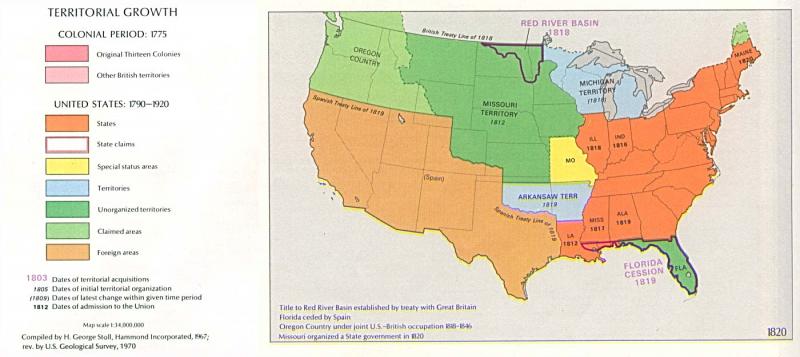U.S. territorial growth, 1820
U.S. territorial growth, 1820
Maine - as part of the Missouri Compromise, Maine entered the union as a free state in 1820. The compromise kept the number of slave and free states equal to ensure their equal representation in the Senate. Florida - in 1819, Spain ceded (gave up) Florida to the United States. What had been "Western Florida" became parts of the new states of Alabama, Mississippi, and Louisiana. Missouri -the southernmost part of the Missouri Territory had enough white population by 1820 that residents wanted to enter the union as a state. Their desire to become a slave state set off protests and debates that ended in the Missouri Compromise. Louisiana - the area north and west of New Orleans had been settled by the French and Spanish for centuries, and after the Louisiana Purchase it was quickly organized into the state of Louisiana. Arkansaw Territory - the region just north of the state of Louisiana was organized into the Arkansaw Territory. It would later become the state of Arkansas and part of Oklahoma. New Spain - the 1819 treaty between the United States and Spain also set the boundary between the U.S. and New Spain, the Spanish territories in North America. In 1821, Mexico achieved its independence, and the territory shown here in orange became part of the new nation of Mexico. Red River Basin - the Red River Basin was not part of the Lousiana Purchase but was obtained from Great Britain by a treaty in 1818. The treaty declared the boundary between the U.S. and Canada to be the 49thparallel -- that is, the line of latitude at 49 degrees north of the equator -- as far west as the Rocky Mountains. Missouri Territory - most of the Louisiana Purchase was organized into the Missouri Territory, named for the Missouri River that ran through it.

Public Domain
Public Domain is a copyright term that is often used when talking about copyright for creative works. Under U.S. copyright law, individual items that are in the public domain are items that are no longer protected by copyright law. This means that you do not need to request permission to re-use, re-publish or even change a copy of the item. Items enter the public domain under U.S. copyright law for a number of reasons: the original copyright may have expired; the item was created by the U.S. Federal Government or other governmental entity that views the things it creates as in the public domain; the work was never protected by copyright for some other reason related to how it was produced (for example, it was a speech that wasn't written down or recorded); or the work doesn't have enough originality to make it eligible for copyright protection.